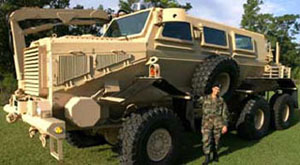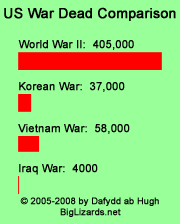May 13, 2007
The War: Plus Ça Change, Plus Ce N'est Pas la Même Chose
Much ado is made of a point -- a cliche, in fact -- that I thought should be fairly obvious: The longer we fight, the more -- and the faster -- the enemy adapts to our methods; but so too, the more and faster we adapt to the enemy's adaptations.
Some Democrats appear to find great cause for rejoicing in the first part of this truism; they hope it signals imminent defeat, allowing them to get on with the urgent task of capturing more seats in Congress and electing a Democratic president. However, by ignoring the second part of the truism, they set themselves up for the catastrophic possibility of America winning.
Let's take a single example: When the enemy realized that we mostly moved soldiers around the battlefield on Humvees, they began attacking them with great effectiveness; IEDs account for most of the 3,300 deaths of our servicemen in Iraq. We responded by switching to the Light Armored Vehicle (LAV) Stryker at the end of 2003 (and by "up-armoring" the Humvee, but that was never particularly satisfactory). The Strykers proved extraordinarily resistant to rocket-propelled grenades (RPGs) and even to the small improvised explosive devices (IEDs) that had killed so many Humvees during the months following the rise of the insurgency in late 2003.
There is no question that the Stryker offered far more protection than the Humvee and troop-transport trucks; and since it was never intended to replace M1 main battle tanks or M2 Bradley Fighting Vehicles, it's counterproductive to compare them. Alas, by late 2006/early 2007, the insurgents in Iraq -- with much help from Iran -- started effectively killing Strykers (and sometimes the men inside) in a number of ambushes. They had learned to buried heavy explosives, shaped charges, and explosively formed penetrators (EFPs), which the Strykers were never designed to repel:
A string of heavy losses from powerful roadside bombs has raised new questions about the vulnerability of the Stryker, the Army's troop-carrying vehicle hailed by supporters as the key to a leaner, more mobile force.
Since the Strykers went into action in violent Diyala province north of Baghdad two months ago, losses of the vehicles have been rising steadily, U.S. officials said.
A single infantry company in Diyala lost five Strykers this month in less than a week, according to soldiers familiar with the losses, who spoke on condition of anonymity because they are not authorized to release the information. The overall number of Strykers lost recently is classified.
Clearly, the enemy has "gotten the Strykers' number," at least if he has a chance to prepare a big enough bomb in advance and plant it deep enough not to be spotted: The Stryker's undercarriage is not heavily armored, and its flat surface makes it an ideal target for EFPs.
The insurgents also apparently are becoming better at hiding the devices - the IED that killed the six soldiers and the journalist was believed hidden in a sewer line. To add potency, insurgents surrounded the device with cement to channel the blast force up into the tank, according to soldiers familiar with the investigation.
Supporters of the Strykers say all that proves that it's the lethality of bombs in Iraq - not the Strykers themselves - that are the problem: The bombs are now so powerful that even Abrams main battle tanks are vulnerable to some of them.
The natural tendency for proponents of tracked vehicles is to point to the Stryker's wheels and say, "Well there's yer problem right there, lady!" Unfortunately, the Abrams MBT and the Bradley have also been killed at somewhat disturbing rates lately; we're fighting a completely different kind of warfare than the Gulf War, during which those two tracked vehicles received their baptism of fire. I honestly think the wheels vs. tracks controversy is a false herring.
The real problem is simply that the most common method of attacking any vehicle in Iraq today -- and in Afghanistan tomorrow, I'm sure -- is from below; and until very recently, no American combat vehicle was specifically designed to counter such attacks... which are not very common in "force on force" warfare. (This is another instance where counterinsurgency strategy differs from the strategy when opposing an enemy army.)
There simply is no way to put enough armor on the undercarriage of a Stryker (or Humvee, Abrams, or Bradley) to prevent a big enough EFP punching through it; the culprit is the flat surface of the undercarriage itself... it's like smashing a wall with a battering ram: Hit hard enough, and you're going to punch right through, because there's nowhere else for the force to go. (It helps that the EFP is also white hot, melting the steel enough to reduce material strength.)
But don't forget the second half of the truism above; the enemy had his inning, and now it's ours...
Enter the MRAP: the Mine Resistant Ambush Protected class of vehicles. The Marines and the Army have more or less settled on the Couger H-series of MRAP and the Buffalo H-series of Mine Protected Route Clearance (MPCV) vehicles, both manufactured by Force Protection Inc... the latter being a somewhat larger version of the Cougar, equipped with a fork-toothed arm for explosive ordnance disposal (the Buffalo's nickname is "the Claw"):


Couger H-series MRAP (L) and Buffalo H-series MPCV (R)
The great innovation of the MRAP is to redesign the undercarriage itself... and to correct the flaw that made our earlier combat vehicles so vulnerable: their underbelly flatness. MRAPs have a V-shaped hull that channels blast effect to the sides of the vehicle, graphically demonstrated here. Even EFPs have trouble penetrating the undercarriage of an MRAP:

MRAP taking blast; explosive force is redirected to sides of vehicle
The design of the MRAP actually dates back more than three decades to counterinsurgency operations in South Africa. The basic idea of a V-shaped hull to channel radiant energy is even older, being the same principle used in "radar-deflecting" airplane hulls, which have been in development at Lockheed's "Skunk Works" since the early 1970s (they won the actual contract for development of the F117A stealth attack aircraft in 1978); and in a sense, the very idea of the prow of a boat being "pointy" is the same principle in action on the surface of the water.
The Army and Marines have currently ordered 7,774 Cougers, and the program has the very enthusiastic support of Secretary of Defense Robert Gates:
Well, I think the first thing that caught my attention, as is often the case, was a newspaper article that indicated that, out of something like 300 incidents involving IEDs, where these MRAP vehicles were involved, no Marines had been killed. And that certainly got my attention.
But the actual buy will likely be much higher, as Multi-National Corps-Iraq, Lt. Gen. Raymond Odierno, has ordered the entire fleet of Humvees in Iraq to be replaced by MRAPs over the next two years, according to the Army Times:
Acting Army Secretary Pete Geren confirmed today that the Army is set to substantially increase the number of Mine Resistant Ambush Protected vehicles it had planned to buy, replacing within two years the 17,700 Humvees now in Iraq....
The Marine Corps already has more than 100 MRAPs on the ground in Iraq, and the Army will field the first of its 2,500 MRAPs in Iraq beginning in August, 700 of which are already in hand, Geren said.
The MRAP program has moved quickly and is a joint procurement effort between the Army and Marine Corps.
What has held back fielding of more MRAPs is not a "hidebound" military culture or the unwillingness to adapt to changing circumstances. Like upgrading personal body armor for soldiers, the real roadblock is that there aren't enough assembly lines to turn out MRAPs at the speed we need them. That will be the biggest hurdle we'll have to overcome to completely replace the fleet of Humvees (and possibly even Strykers) in the timeframe demanded:
As of July 2006, more than 200 Buffalo and Cougar vehicles were deployed in Iraq and Afghanistan without a fatality, despite more than 1,000 mine detonations and IED attacks (see DefenseTech for an especially hilarious example). With more orders in the pipeline from American, Iraqi, and now British customers, meeting production demand has become a challenge for a firm that had just 12 employees at the beginning of 2004.
Force Protection, Inc. hired its 500th employee in July 2006, and a July 17, 2006 release noted that they are engaged in efforts to triple their internal manufacturing capacity. A second and third Cougar production line is being put in place following $41 million of equity financing, and production of its Buffalo variant is also slated to double.
Despite a bit of a slow start, the point carries, I believe. The second half of our cliche above continues to hold true: The enemy adapted to our Humvees and started killing them; we responded by up-armoring them and introducing Strykers. Then the insurgents figured out how to attack our vehicles from below with heavy explosive force... and again we responded, this time with a whole new (for us) class of vehicles, the MRAPs.
In the innovation race, we have the choice to place our money on the United States military and the militaries of our allies -- or on a bunch of Iranian fanatics and their flying monkeys in the Mahdi Militia.
I know where my bet is going.
Hatched by Dafydd on this day, May 13, 2007, at the time of 11:50 PM
Trackback Pings
TrackBack URL for this hissing: http://biglizards.net/mt3.36/earendiltrack.cgi/2070
Listed below are links to weblogs that reference The War: Plus Ça Change, Plus Ce N'est Pas la Même Chose:
» Wacking the Moles, Sealing the Holes from Big Lizards
Warning, this post contains no great analysis, no brilliant insights, and no genius-level discovery of hitherto unrealized connections. In other words, it's a great departure from typical Big Lizards fare. Instead, I assume the smart-man's burden of st... [Read More]
Tracked on June 26, 2007 4:16 PM
» The Rap on MRAPs from Big Lizards
Last Saturday, an attack on an "MRAP" (Mine Resistant Ambush Protected) vehicle successfully destroyed the vehicle and killed one of the four occupants. But far from a slam, this very attack proves just how effective the MRAP truly is. Important... [Read More]
Tracked on January 22, 2008 4:47 PM
Comments
The following hissed in response by: Insufficiently Sensitive
Solution to production: same as WWII.
The Willys company invented the Jeep. No way it had the capacity to make enough for the operations then ongoing. So the gummint set up the Ford company to make enormous quantities based on the Willys patents. Willys got royalties and the doggies got Jeeps.
And now that Detroit is going bust due to its dinosauric health and retirement giveaways, here's a chance to revive some domestic production. Don't count on Congress to fix the fossilized union contracts, but Ford, Chrysler, GM might be able to stagger on a bit longer making MRAPs based on Force Protection Inc patents.
Oh, yeah, it may not fit Congressional concepts of bugging out of Iraq next week, but at least some of their union buddies would cut a fat hog on the deal.
The above hissed in response by: Insufficiently Sensitive ![[TypeKey Profile Page]](http://biglizards.net/blog/nav-commenters.gif) at May 14, 2007 9:02 AM
at May 14, 2007 9:02 AM
The following hissed in response by: RattlerGator
I love the fact that we're allowing them to show their limited hand while employing our versatility and suffering relatively few casualties.
Every increased effort they make strengthens our arsenal for future use. If the surrender monkeys can be fought off long enough, that is.
The above hissed in response by: RattlerGator ![[TypeKey Profile Page]](http://biglizards.net/blog/nav-commenters.gif) at May 14, 2007 2:59 PM
at May 14, 2007 2:59 PM
The following hissed in response by: Bill Faith
Excellent post, Dafydd. I don't think I've seen the MRAP explained better anyway. I added an excerpt and link to my 2007.05.14 Dem Perfidy // Islamism Delenda Est Roundup. I do have one quibble, though. Other sources I read and trust say the bottleneck on fielding MRAPs promptly isn't the manufacturer, it's Congress. American Soldiers and Marines are dying while the Dhimmicrats play political games with funding and I hope and pray they burn in Hell for it.
Halfway down the road to hell,
In a shady meadow green,
Are the souls of all dead troopers camped
Near a good old-time canteen.
And this eternal resting place
Is known as Fiddler’s Green.
-- Author Unknown (via Sgt Hook)
Rumor has it the canteen is equipped with HDTV so the troops can watch the Dhimmis enjoy their eternal reward. If it isn't it should be.
The above hissed in response by: Bill Faith ![[TypeKey Profile Page]](http://biglizards.net/blog/nav-commenters.gif) at May 14, 2007 3:28 PM
at May 14, 2007 3:28 PM
The following hissed in response by: Bill Faith
"better anywhere," not anyway. Preview is your friend, Bill.
The above hissed in response by: Bill Faith ![[TypeKey Profile Page]](http://biglizards.net/blog/nav-commenters.gif) at May 14, 2007 3:30 PM
at May 14, 2007 3:30 PM
The following hissed in response by: Dafydd ab Hugh
Bill Faith:
No, I mean even for the orders already placed, for which we already have money in hand: It's not clear that we can replace 17,700 Humvees with Cougars within two years, even if the money were already sitting in Force Protection Inc's own checking account.
We have a lot of money available for new combat vehicles; that's not the bottleneck. It's that it just takes a long time to build one; and it would take a very long time to create new assembly lines at other companies (like General Motors) to build vehicles they're not set up to build.
It might still be a good long-term investment; but it won't solve our Iraq problems in the near term. For that, it's going to be FPI or nobody.
Besides, the Democrats have already picked up the MRAP mantra: "Why didn't that miserably incompetent Bush send in Cougars instead of Humvees in the first place?"
Funding for MRAPs will be in whatever bill they eventually pass.
Dafydd
The above hissed in response by: Dafydd ab Hugh ![[TypeKey Profile Page]](http://biglizards.net/blog/nav-commenters.gif) at May 14, 2007 5:01 PM
at May 14, 2007 5:01 PM
The following hissed in response by: Tomy
The above hissed in response by: Tomy ![[TypeKey Profile Page]](http://biglizards.net/blog/nav-commenters.gif) at May 15, 2007 5:04 AM
at May 15, 2007 5:04 AM
The following hissed in response by: Tomy
Some facts for the soup:
- The Humvee replaced the Jeep.
- The Stryker is Shinseki's dream-baby. It was a quick off-the-shelf solution to the Kosovo embarassement; the army couldn't get the Bradley and Abrams into the area because of high vehicle weight. The Stryker's low weight was more important than survivability
- Wheels vs. Track is not based on aesthetics or preferences. Plain and simple, track is required for heavy vehicles. The Abrams and Bradley vehicles require track because they are heavier than the Stryker.
- Bottom line:
- Humvees, Jeep replacements, were not designed to operate against bullets and bombs.
- There should be no surprise regarding Stryker vulnerability, this was a trade-off for a lighter vehicle; Army brass knew this and Congress knew this.
- We don't know the damage statistics for the Abrams and Bradley vehicles, but I think history will show that they did well.
Tomy
The above hissed in response by: Tomy ![[TypeKey Profile Page]](http://biglizards.net/blog/nav-commenters.gif) at May 15, 2007 6:28 AM
at May 15, 2007 6:28 AM
Post a comment
Thanks for hissing in, . Now you can slither in with a comment, o wise. (sign out)
(If you haven't hissed a comment here before, you may need to be approved by the site owner before your comment will appear. Until then, it won't appear on the entry. Hang loose; don't shed your skin!)© 2005-2009 by Dafydd ab Hugh - All Rights Reserved













